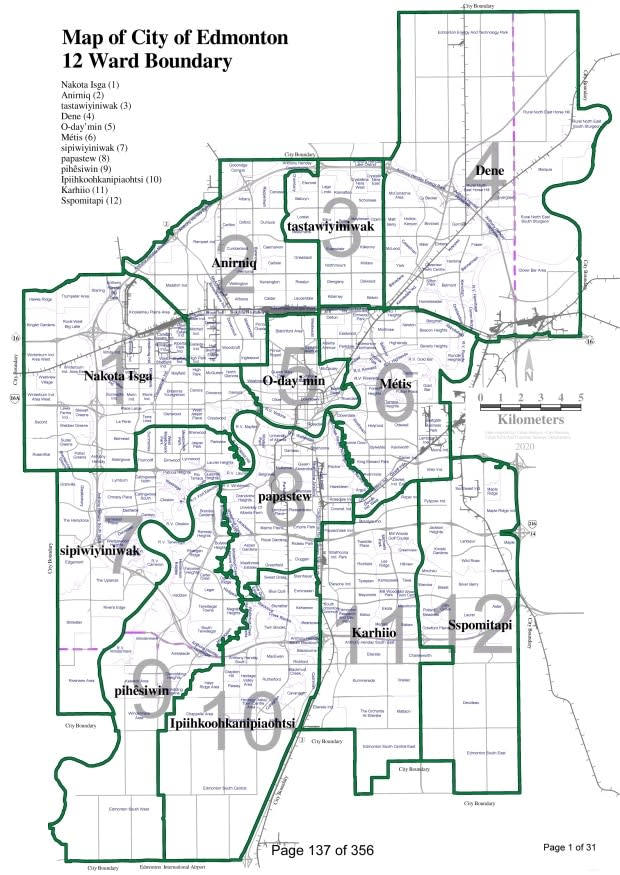Edmonton council endorses Indigenous names for city's revamped wards
Move over ward numbers, here come Anirniq, Dene and Nakota Isga.
Edmonton city council supported the adoption of Indigenous names to represent Edmonton's 12 redrawn ward boundaries in a preliminary vote Monday.
The Indigenous names will replace the previous ward numbers 1 to 12, if council gives final approval due in December.
Mayor Don Iveson said the new names are a tangible bid to show reconciliation for years of the residential school system and try to help revitalize traditional languages.
"We have a small opportunity to right some of those wrongs by embracing the languages of this land without caveat, without asterisks, without footnotes," Iveson said.
Iveson noted the number system didn't provide any context of the region's history, unlike the Indigenous names.
"Behind each one of them is a powerful story," he said. "People will ask 'what does it mean?' but no one will ask what it means if it's just a number."
The city's naming committee worked with Indigenous communities over two months before presenting the choices to council Monday.
In a 9-to-4 vote, the majority of council supported the Indigenous names with Coun. Moe Banga, Mike Nickel, Tony Caterina and Jon Dziadyk voting against.
Banga suggested the city could hyphenate some of the words to represent other cultures in the city but that idea didn't gain traction with other councillors or the naming committee.
Dziadyk suggested including numbers next to the Indigenous names but the majority of council said the numbers would only confuse things.
Each proposed name has a geographical or cultural connection to the historical landscape.
O-day'min is Anishinaabe for "the heart through which the North Saskatchewan River runs." It's in the central part of Edmonton, now labelled by mainly wards 6 and 2.
Karhiio is Mohawk for "a tall beautiful forest." This municipal ward is in the southeast part of the city.
Dene, the name suggested for the northeast section that is now mostly Ward 4, means all people of land and water.

Council asked the naming committee to explore Indigenous names in June, after receiving a list of options based on a geographical naming convention.
Those included Jasper Place, Northwest, North, Northeast, Central, East, West, Scona, Whitemud, South, Gateway and Southeast.
The new names were presented after the ward boundary commission completed its revamped electoral map in May, which adjusted borders according to the shifting population and changing neighbourhoods.
Bev Esslinger, councillor for Ward 2 in the northwest, said she's tried to explain the old ward numbers since she was elected seven years ago.
"I'd rather explain the name because the name Anirniq is an Inuit word and it really is connected to the history of the people in the ward that had treatment at the Charles Camsell Hospital," Esslinger said. "I would rather celebrate this word than explain what two means, and where two is."
Terri Suntjens, director of Indigenous Initiatives at MacEwan University, worked on the ward naming initiative as a co-chair.
The daughter of a residential school survivor, Suntjens said she didn't learn Cree as a child as her father was punished for trying to speak it.
"Unfortunately my parents didn't speak Cree to me," Suntjens said. "I try and it's difficult as an adult to learn that."
Suntjens said one of her passions is now to work to preserve Indigenous languages.
It's also a motivator to learn for councillors like Esslinger.
"You're honouring us by allowing us to use these names."
Pronunciation
Coun. Sarah Hamilton, noted some concerns from people who don't know how to say the names.
"While the lexicon may be a challenge in pronunciation at first, it's something that people have learned through practice," Hamilton said.
She likened the exercise to other place names people have learned over the years, such as Maskwacis, Wetaskiwin and even Saskatchewan.
Rob Houle, co-chair on the initiative and a writer and researcher, agreed and said the names shouldn't pose much of a problem, as people often learn how to say difficult family names.
"I would hope that people would want to say the names, approach it with an open mind and an open heart," Houle said.
Coun. Michael Walters said he pinned down the pronunciation of Ipiihkoohkanipiaohtsi in a couple of minutes.
The suggested name for the south central part of the city, pronounced "Ee-pee-ko-ka-knee piu-tsi-ya," is Blackfoot and refers hunting patterns and traditional migration of buffalo.
The city must allow for a 60-day petition period before presenting the bylaw for second and third reading, scheduled for Dec. 7. Council must pass its new ward names by the end of the year, ahead of the next municipal election in October 2021.

